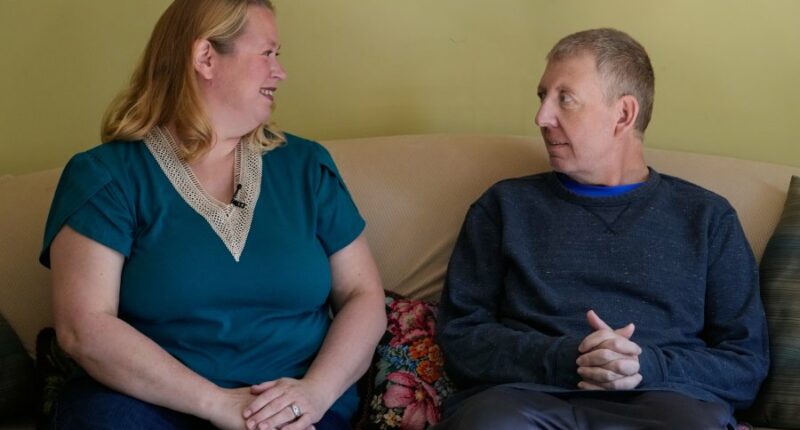Share this @internewscast.com

MINOOKA, Ill. (AP) — Bill Swick is living with a rare degenerative brain disorder that affects both his movement and speech. Rather than endure the lengthy journey to a speech therapist in downtown Chicago, he has enjoyed the convenience of virtual therapy sessions straight from his home.
However, for the past month, Swick, who is 53, has been unable to access these online appointments.
The ongoing federal government shutdown, now in its fifth week, has suspended funding for the Medicare telehealth program that covers these services. Consequently, Swick and his wife have resorted to using traditional techniques instead of acquiring new strategies to cope with his increasing challenges in processing language, articulating words, and regulating his speech pace.
“It’s frustrating because we want to keep moving forward with his progress,” said Martha Swick, 45, who has been her husband’s caregiver since his diagnosis three years ago. In an interview at their Minooka, Illinois home, she explained, “I try to organize all of his therapy to make his day easier and smoother, and then everything hits a snag, and we have to pause and wait.”
The Swicks’ situation echoes the frustrations of millions of Medicare fee-for-service patients who have relied on telehealth waivers introduced during the pandemic to attend medical appointments from home.
With Congress at an impasse over government funding, these waivers have expired despite bipartisan support. This leaves healthcare providers in a dilemma, as they must decide whether to continue offering telehealth services without assured reimbursement or to cease virtual visits entirely.
That’s left a patient population of mostly older adults with fewer options to seek specialists or get help when they can’t physically travel far from home.
Swick, whose corticobasal degeneration causes symptoms similar to Parkinson’s disease, can’t feed or dress himself anymore and struggles with balance and walking. Add on the logistical nightmare of driving to the city in traffic, and in-person speech therapy appointments aren’t a worthwhile ordeal for him and his wife.
But missing even a few appointments can impede progress for patients with dementia and other degenerative conditions who depend on continuity of care, experts said.
It “feels like you’re taking a step back,” Swick said in the interview.
A temporary pause, with significant impact
Before the COVID-19 pandemic, Medicare only paid for virtual medical appointments under narrow circumstances, including in designated rural areas and when patients logged in from eligible sites, like hospitals and clinics.
That changed in 2020, when Trump’s first administration dramatically expanded telehealth coverage in response to the public health emergency. Medicare started reimbursing a wide range of telehealth visits, stripping the geographic requirement, and allowing patients to take calls from their homes.
Congress has routinely extended the telehealth flexibilities and was poised to do so again before their Sept. 30 expiration. But when budget negotiations stalled and the government shut down Oct. 1, the vote never happened, leaving the program temporarily unfunded.
With more than 4 million Medicare fee-for-service beneficiaries using telehealth in the first half of 2025, according to Brown University’s School of Public Health, the pause has had a major impact on an already vulnerable population.
Swick’s speech therapy services are provided by the Chicago-area business Memory and Aphasia Care. Owner Becky Khayum said many of her clients are in different cities and states and sought her therapists out because they specialize in frontal temporal dementias.
“Now suddenly without telehealth services, they do not continue to have the support to participate in those activities that are so important to them,” Khayum said. “The risk is we could see social withdrawal; we could see depression and anxiety increased.”
Virtual visits can also be useful in different areas of medicine. Dr. Faraz Ghoddusi, a family medicine provider in Tigard, Oregon, said he uses telehealth to check in and help his patients manage their conditions, like diabetes and chronic lung disease. He said that in the current Medicare telehealth pause, one of his patients wasn’t having regular check-ins and ended up in the emergency room.
Susan Collins, 73, in Murrieta, California, said Medicare-reimbursed telehealth appointments were a “tremendous relief” to her when she was a full-time caregiver for her late husband, Leo. Before he died last year from progressive supranuclear palsy, a rare brain disorder, she struggled to lift him from his wheelchair in and out of the car for his in-person doctor visits 60 miles from their home.
“He was much safer at home,” Collins said, noting that telehealth was a useful resource when her husband needed a medication or symptom consultation but not a complete physical exam.
Doctors respond differently, leaving a patchwork
The latest guidance from the Centers for Medicare and Medicaid Services does not ban medical providers from providing telehealth services during the lapse – but it stops short of promising they’ll be reimbursed if they do.
In response, providers are deciding whether they can absorb the risk of continuing care without assurance that they’ll be paid for it when the government reopens.
Khayum in Illinois said she had to stop providing telehealth services to Medicare patients because her small business couldn’t handle the volatility of potentially losing out on payments. Ghoddusi, the family medicine provider, said his Oregon practice is honoring telehealth appointments made before Oct. 1 but not scheduling additional ones for Medicare patients until the funding is restored.
Genevieve Richardson, owner of a speech pathology business in Austin, Texas, has stopped providing telehealth services to her Medicare clients who are spread across the country. She has been referring them to outpatient clinics in their areas who can provide stopgap services in person.
Major hospitals are also grappling with whether to provide virtual care to Medicare patients. Dr. Helen Hughes, medical director of the Office of Telemedicine at Johns Hopkins Medicine, said the hospital initially continued the care, but paused scheduling more Medicare telehealth visits as of Oct. 16 as the shutdown continued.
She said the uncertainty surrounding the waivers has been “a total roller coaster.”
The congressional stalemate persists
The government shutdown is in its fifth week with no clear end on the horizon. Meanwhile, Medicare telehealth flexibilities and a separate Medicare program offering patients hospital-level care at home both remain paused.
Mei Kwong, executive director of the Center for Connected Health Policy, said the simplest solution to renewing the telehealth waivers would be for Congress to vote separately on them.
The hands of federal health care administrators “are kind of tied,” she said. “So, you really do need Congress to act.”
But with lawmakers divided and looking for leverage, hopes for such action are low.
Martha Swick, practicing word exercises with her husband in their home on a recent morning, said if a solution isn’t found soon, “my resource collection is going to run out.”
“I’m just doing what I’m able to at home as a wife and a caregiver,” she said. “But eventually I’m really going to need those appointments to come back.”
___
Swenson reported from New York.
















